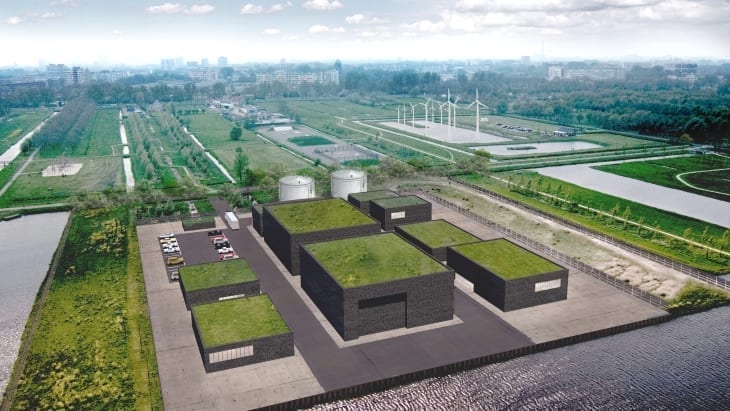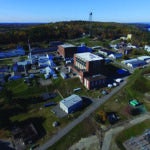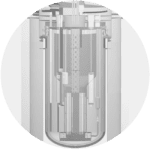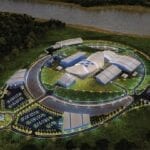Moltex Energy, a privately held nuclear power development company headquartered in the UK with an office in New Brunswick, Canada, has entered into a collaboration agreement with Canadian Nuclear Laboratories (CNL) to support Moltex’s nuclear fuel development program for its Stable Salt Reactor (SSR), among the latest technology advancements for small modular reactors (SMRs). The agreement is backed by CNL’s Canadian Nuclear Research Initiative (CNRI).
Moltex Energy’s SSR is a 300-MWe SMR. The company’s latest research and development supports the second and third phases of the Oxide Nuclear Waste Reduction Demonstration (ONWARD) project, which explores the commercial viability of the Waste To Stable Salts (WATSS) technology to convert used CANDU (CANadian Deuterium Uranium) fuel into new fuel, enabling production of clean energy from an SSR. The first phase of the program is ongoing. CNL is the developer of the CANDU process, featuring a pressurized heavy water reactor (PWR).
Technological advancements in SMRs and nuclear power for distributed generation will be part of POWER’s Distributed Energy Conference in Chicago, Illinois, Oct. 19–21, 2020. Projects designed to provide support for grid integration of renewable resources, such as that being developed by Moltex, along with those able to provide access to electricity in remote areas, will be discussed.
SMRs have been a focus of advancements in nuclear power technology worldwide, including across Europe, as well as in the U.S. and China.
Testing in New Brunswick
Moltex Energy, the University of New Brunswick (UNB), and CNL will design, build, and optimize a fuel-testing apparatus at UNB’s Centre for Nuclear Energy Research as part of the CNRI project. Work will be done in parallel with complementary activities at the University of Manchester in the UK. Under the CNRI project, CNL will support Moltex Energy with the preparation of specialized equipment, along with the installation and commissioning.
Initial project testing is done using surrogate inactive materials. CNL supports the planning, design, cost, and safety analysis required to move the apparatus into a shielded facility, or “hot cell,” where testing can be completed using real fuels and active materials.
Data collected during testing will support the design and licensing of a WATSS facility at Point Lepreau in New Brunswick, an installation being developed jointly by Moltex Energy, NB Power, and the New Brunswick government.

“This is positive news and will advance our project in Canada,” said Rory O’Sullivan, Moltex’s CEO for North America, in a statement April 23. “Nuclear power is essential to address our global energy issues as intermittent renewables alone cannot meet the current and future demand. Many countries around the world have stores of used nuclear fuel from their current nuclear plants and we have discovered a clean, safe and economical way to recycle what some consider waste into a fuel for our Stable Salt Reactor to create more clean energy and significantly reduce the amount of long-lived radio-nuclides.”
“I’m pleased to see this partnership between CNL and Moltex Energy and moving SMR technology another step forward,” said the Honourable Mike Holland, Minister of Natural Resources and Energy Development for the Government of New Brunswick, in a statement. “Our Government believes in SMR technology and the tremendous potential it can bring to our economy and to the green energy landscape around the world.”
Fuel Dissolved in Salt
Moltex’s SSR uses fuel dissolved in a molten fluoride or chloride salt, which also functions as the reactor’s coolant, designed to operate at atmospheric pressure. According to Moltex, “The fuel salt is held in vented tubes. Venting is safe because in our reactors the dangerous fission products form stable compounds, not gases. The tubes are bundled into fuel assemblies similar to those in a conventional PWR. These are held in the support structure which forms the reactor modules.
“The tank is filled with a safe molten salt coolant, which is not pressurized like gas or water coolants in today’s power reactors and not violently reactive with air and water like sodium in today’s Fast Breeder reactors. A second similar coolant salt system takes heat from the primary coolant salt to our patented GridReserve energy storage system.”
Moltex’s GridReserve is a group of molten salt storage tanks. The tanks store gigawatt-scale thermal energy, when that energy is not needed to produce electricity. When demand for power increases, and renewable resources are not available, the facility can take heat from the reactor and storage tanks to produce electricity.
The process is similar to a concentrated solar power (CSP) plant and uses the same solar salt. The refueling process involves moving fuel assemblies sideways out of the core, and replacing them with fresh fuel assemblies. The reactor is continuously cooled by natural air flow, which guards against overheating.
A 300-MW SSR system consists of two 150-MW modules, which are factory-built and contain support structure for the fuel assemblies, heat exchangers, and all the needed pumps and controls. According to Moltex, “The rectangular core modules are held in a larger tank, which is filled with a molten salt coolant. A second similar coolant salt system takes heat from the primary coolant salt.”
CNRI Initiative Accelerates SMR Deployment
CNL launched the CNRI initiative in July 2019. The project is designed to accelerate SMR deployment by enabling research and development, and connecting global vendors of SMR technology with the facilities and expertise within Canada’s national nuclear laboratories.
California-based Kairos Power, Moltex Canada, Terrestrial Energy Inc. (with offices in New York, Ontario, and the UK), and Seattle, Washington-based UltraSafe Nuclear Corporation were selected in November 2019 as the first companies to receive support from the CNRI program. The companies are expected to match the contributions from CNL either monetarily, on in-kind.
“CNL has built considerable expertise in nuclear fuel handling and processing over the past decades and advanced fuel research is recognized as one of our key strategic areas of strength,” said Jeff Griffin, CNL vice-president of science and technology, in a statement. “We have made significant investments into our fuel program and will continue to do so over the coming years. The CNRI program helps reactor developers, such as Moltex Energy, tap into these key capabilities in a cost-effective way.”
—Darrell Proctor is associate editor for POWER (@DarrellProctor1, @POWERmagazine).










